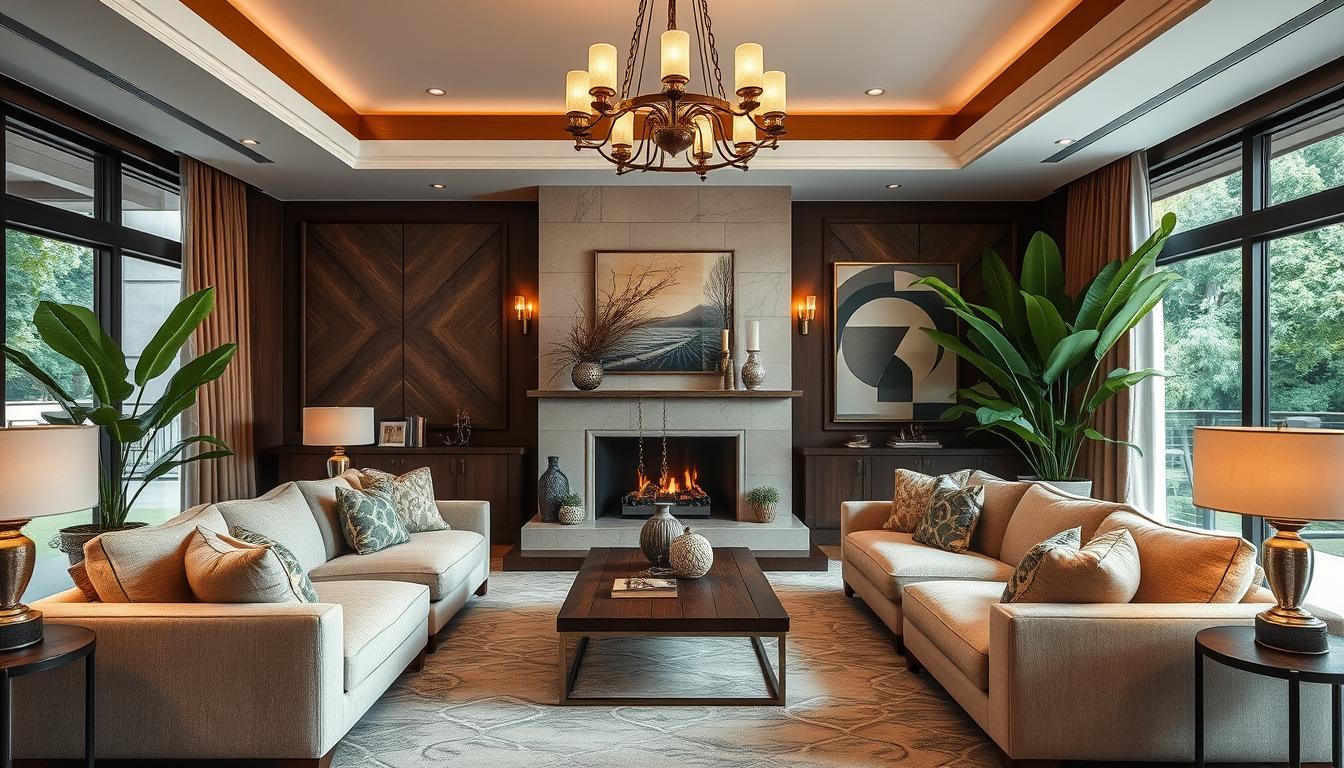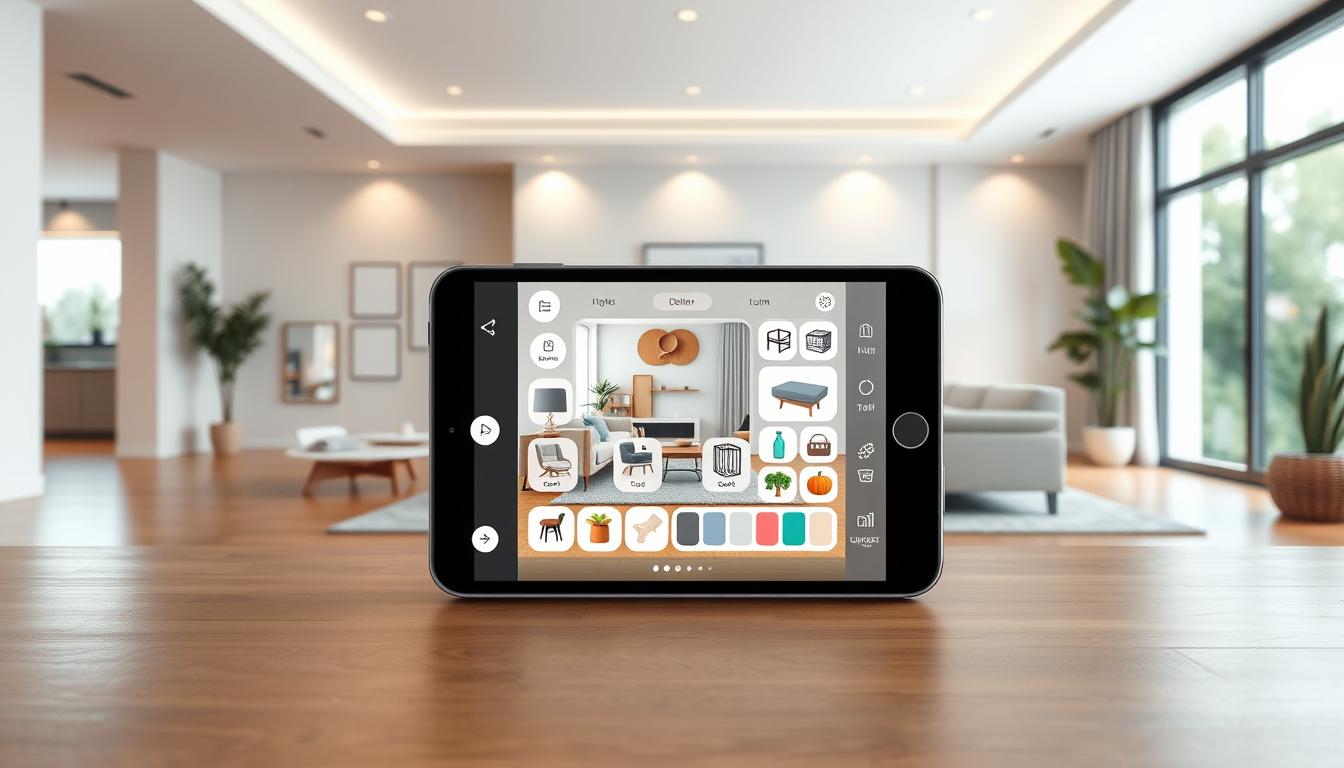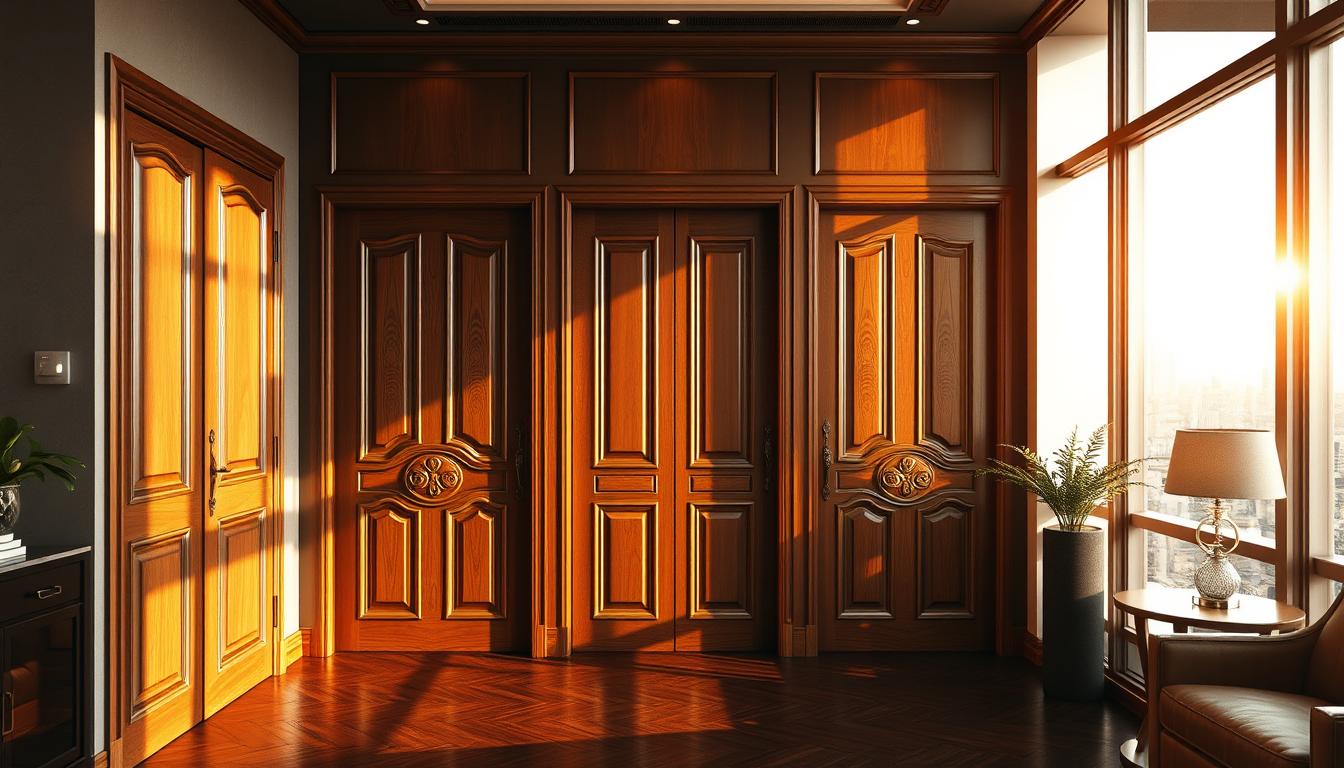Did you know a well-designed home can boost its value by up to 10%? This shows how important interior decorating ideas are. They not only make your home look better but also increase its value. We think that great interior designs turn a house into a home, a place that shows off your style.
Our expert advice can help you make your living space better with our interior design ideas. Whether you want to update one room or redo your whole house, we’ve got tips to help. Our goal is to help you create the home you’ve always dreamed of.
Key Takeaways
- Understand the importance of interior design in home valuation
- Discover expert tips for elevating your living space
- Learn how to choose the right interior decorating ideas for your home
- Explore curated interior design ideas for a stylish and functional home
- Transform your house into a home with our guidance
Understanding the Importance of Interior Design
Interior design is more than just looks. It makes a home work better. It’s about making a space that looks good and feels right for everyday life.
A good interior design can really change how we feel and work. By using modern home design ideas, like open spaces and simple decor, we can make our homes peaceful and calm.
Enhancing Functionality and Aesthetics
Good interior design makes a space both useful and beautiful. It’s about picking furniture and decor that look great and are useful too.
For example, choosing furniture that does more than one thing can save space in small homes. It also makes the room look better.
Creating a Comfortable Living Space
Making a living space cozy is key in interior design. We need to think about lighting, colors, and textures to make it feel welcoming.
By mixing these elements right, we can make a home that’s both cozy and perfect for relaxing and having fun.
Key Elements of Great Interior Designs
A well-designed home is more than just stylish pieces. It’s about creating a space that improves your life. Great interior designs combine several key elements for a harmonious living space.
Color Schemes That Inspire
The right color scheme can change a room’s feel. It can make a room feel bigger, cozier, or more lively. Think about the mood you want in each room.
Calming colors like blues and greens are great for bedrooms. Bold colors like reds and oranges can energize living areas.
The Role of Lighting
Lighting is key in interior design. It greatly affects a room’s feel. There are three main types: ambient, task, and accent lighting.
Ambient lighting lights up the whole room. Task lighting is for specific tasks, like reading. Accent lighting highlights certain areas or features.
| Type of Lighting | Purpose | Examples |
|---|---|---|
| Ambient Lighting | Overall illumination | Ceiling fixtures, natural light |
| Task Lighting | Specific tasks | Desk lamps, under-cabinet lighting |
| Accent Lighting | Highlighting features | Spotlights, picture lights |
Furniture Selection
Furniture selection is more than just looks. It’s about choosing pieces that are functional and comfy. Make sure the furniture fits well in the room.
Think about your lifestyle and needs when picking furniture. For example, durable, stain-resistant fabrics are good for big families. A comfy chair is essential for working from home.
By focusing on color schemes, lighting, and furniture, you can make a home that’s both beautiful and useful. This will give you creative interior solutions and home décor inspiration every day.
Popular Interior Design Styles
The world of interior design is full of exciting styles. From sleek and modern to warm and cozy, there’s something for everyone. Each style has its own unique characteristics that can make your home reflect your taste and style.
Contemporary
Contemporary design is all about the latest trends and tech. It features clean lines, minimal decoration, and focuses on function. This style often includes luxury interior design elements like high-end materials and new lighting solutions. It creates a sophisticated, modern space.
Rustic
Rustic design celebrates natural materials like wood and stone. It brings the outdoors in with exposed beams, vintage furniture, and earthy colors. Rustic design adds a cozy, welcoming feel to your home.
Minimalist
Minimalist design is all about simplicity and clarity. It removes unnecessary elements to create a clean, uncluttered space. This style uses neutral colors, simple furniture, and lots of empty space. It’s great for those who want a calm, focused living area.
Industrial
Industrial design takes inspiration from old factories and warehouses. It features exposed brick, metal beams, and reclaimed wood. This style is perfect for those who love the raw, edgy look of industrial spaces. It can be made modern by adding comfortable furniture and decorative items.
Knowing these popular styles can help you decorate your home better. Whether you like the sleekness of contemporary or the charm of rustic, there’s lots of inspiration in interior design trends.
| Style | Key Features | Ideal For |
|---|---|---|
| Contemporary | Clean lines, minimal ornamentation, high-end materials | Modern homes, luxury living |
| Rustic | Natural materials, vintage furniture, earthy colors | Cabin retreats, cozy living rooms |
| Minimalist | Simple furniture, neutral colors, negative space | Small spaces, serene environments |
| Industrial | Exposed brick, metal beams, reclaimed wood | Loft apartments, urban homes |
Exploring these styles can help you find the perfect fit for your home. It ensures your home reflects your personality and meets your needs.
Tips for Small Space Interior Design
Turning a small area into a cozy home is possible with the right design. It’s key to use every inch wisely to make the space inviting.
Choosing the right elements is a big challenge in small space design. Use home remodeling ideas for smart furniture, vertical space, and mirrors. These can make a small area feel bigger.
Smart Furniture Choices
Finding the right furniture is vital in small spaces. Pick items that do more than one thing, like a storage ottoman or a coffee table with storage. This saves space and cuts down on clutter.
Experts say furniture with legs, not bulky bases, makes rooms feel bigger. “Keeping the floor clear and creating flow is key,” says a top designer.
“The art of interior design is not just about looks; it’s about making a space that works and shows who you are.”
Utilizing Vertical Space
Using vertical space is a smart move in small design. Shelves, storage, or hanging curtains from the ceiling can make ceilings seem higher. This trick makes the space feel bigger.
Incorporating Mirrors
Mirrors are great for small spaces. They make rooms look bigger by reflecting light and images. Mirrors opposite windows can also brighten the space, making it feel larger.
By following these tips and using home remodeling ideas, you can make your small space stylish and functional.
How to Choose the Right Color Palette
Choosing a color palette that resonates with you is key for great interior designs homes. The colors you pick can greatly change the feel of your space.
Understanding Color Psychology
Colors can make us feel certain ways and change our mood. For example, blue can make us feel calm, while red can energize us. Knowing how colors work can help you pick the right ones for your home. Check out our top home color combination ideas to start.
Think about what each room is for. Bedrooms might need calming colors like light blue or pale green. On the other hand, a home office might do better with colors like orange or yellow to keep you focused.
Testing Colors in Your Home
It’s important to test colors before you decide. Paint samples on walls or use colored cards to see how they look. This helps you avoid making expensive mistakes and ensures your vision comes to life.
Also, think about your home’s natural light and the colors of your furniture and decor. These can affect how your chosen colors look. By testing and considering these, you can create a space that feels welcoming and shows off your style.
Incorporating Artwork into Your Design
Artwork is key in interior design, adding sophistication and personality to your home. It makes your space feel more personal and unique. By carefully choosing artwork, you can boost your home’s look and make it more engaging.
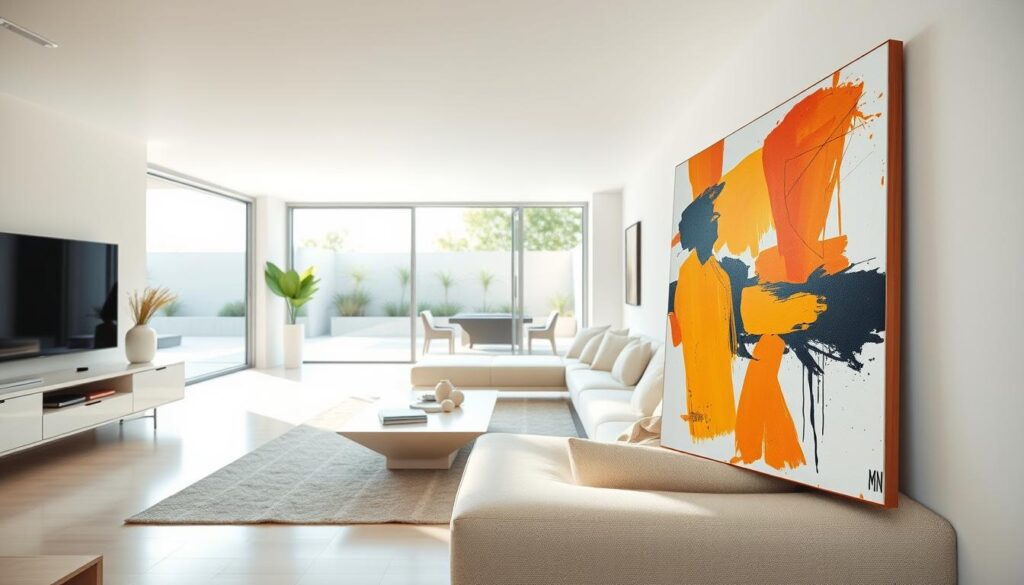
Selecting the Right Pieces
Finding the right artwork for your home can seem hard, but it’s not. Start with pieces that speak to you, like a certain style or theme. Think about the look you want for your home and pick artwork that matches it.
Here are a few tips to keep in mind:
- Consider the scale of the artwork in relation to the room and its furniture.
- Think about the color scheme and how the artwork will fit into it.
- Don’t be afraid to mix different styles and genres to create a unique look.
Art Placement Strategies
After picking the perfect pieces, think about where to put them. The way you display your artwork greatly affects a room’s feel. Try different heights and arrangements to see what works best.
A good rule of thumb is to place artwork at eye level, so it’s easily viewed and appreciated. But, feel free to break this rule for a more dynamic display.
To achieve a stylish home interiors look, try a gallery wall or use artwork to anchor a room’s design. By adding artwork thoughtfully, you can add depth and interest to your modern home design. This makes your space truly special.
Making the Most of Open Spaces
Maximizing open spaces needs careful thought in interior design. Open spaces bring flexibility and freedom to a home. Yet, they can be hard to navigate without a plan.
Zoning with Furniture
One smart way to use an open space is zoning with furniture. This means setting up different areas with furniture, like a living room, dining area, and workspace.
- Use a sofa to mark the living area’s boundary.
- Choose a dining table that fits the space and the number of guests.
- Include a desk or workspace that’s both useful and comfy.
Creating Flow Between Areas
It’s key to make a smooth flow between areas in an open space. This ensures a cohesive and useful design. Think about the path people will take and make sure it’s clear.
- Arrange furniture to guide people through the space naturally.
- Use rugs and lights to define areas and keep the look continuous.
- Don’t overdo it with too many pieces or decorations.
By using these tips, you can make an open space that’s both stylish and practical. It will meet your needs for living, working, and having guests over.
Eco-Friendly Interior Design Ideas
Eco-friendly interior design is changing how we see our homes. It makes them more sustainable and luxurious. As we care more about the environment, adding green elements to our homes is key for many.
Choosing sustainable materials and energy-saving options helps us reduce our environmental impact. This way, we can make our homes beautiful and useful.
Sustainable Materials
Using sustainable materials is a big part of eco-friendly design. These are materials that are recycled, can be recycled, or come from sustainable sources. For example, reclaimed wood, bamboo, and low-VOC paints are favorites among those who care about the planet.
When picking materials, think about their impact from start to finish. Choosing materials with little environmental harm makes your design more eco-friendly.
Energy-Efficient Solutions
Energy-efficient solutions are also crucial in eco-friendly design. This includes LED lights, energy-saving appliances, and smart home tech that cuts down on energy use.
These elements help lower energy costs and support a greener future. For instance, smart thermostats adjust to your schedule to save on heating and cooling.
As we move forward in interior design, eco-friendly practices are here to stay. By using sustainable materials and energy-saving tech, we can create homes that are both luxurious and good for the planet. This gives us the best in home décor inspiration.
Personalizing Your Home Design
Your home should show who you are. We’re here to help you make it happen. Personalizing your home design means creating a space that looks great and feels welcoming. By adding elements that matter to you, your home will stand out.
Family Heirlooms and Personal Mementos
Using family heirlooms and personal mementos is a great way to personalize your home. These items add emotional depth, making your space feel truly like home. Display them in a way that tells a story or starts conversations.
For example, a vintage piece of furniture can be a beautiful centerpiece in your living room. Framing personal photos or memorabilia adds a personal touch to your walls.
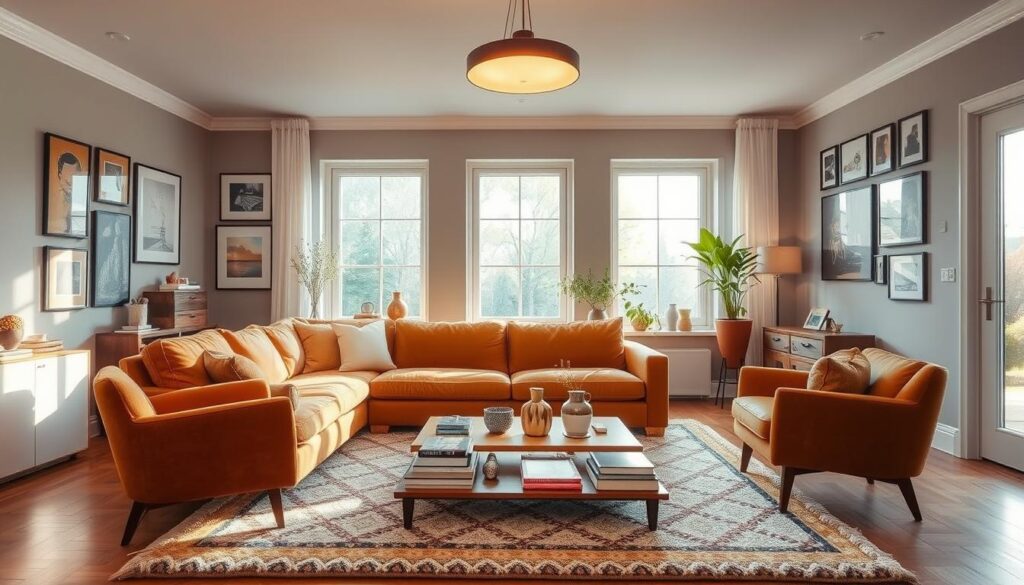
Incorporating Hobbies and Interests
Adding your hobbies and interests to your home design is another great idea. Whether you love reading, music, or crafting, there are many ways to show your passions.
If you’re a book lover, create a cozy reading nook with a comfy chair and a floor lamp. If music is your passion, set up a space for your instruments or display music-inspired art.
The Importance of Lighting Design
Lighting is key in interior design, affecting a room’s feel and use. It’s vital to think about lighting when designing a home. This ensures a welcoming and useful space.
Good lighting can change a room’s look. It can show off architectural details, set a mood, and even affect our mood and work. In home remodeling, lighting design is a must for beautiful interiors.
Types of Lighting to Consider
There are many lighting types for room design. These include:
- Ambient lighting: Gives a room overall light.
- Task lighting: Focuses on areas like reading or cooking.
- Accent lighting: Shows off decorations or art.
Layering Light for Effect
Layering light creates a beautiful and useful lighting design. Mixing different light sources adds depth and interest to a room.
Use overhead lights, table lamps, and floor lamps for this effect. This setup provides enough light and makes the room warm and inviting, typical of great interiors.
Understanding lighting design’s importance helps create a well-lit home. This makes your home remodeling ideas better and more appealing.
Budget-Friendly Interior Design Tips
Creating a stunning home doesn’t have to break the bank. Budget-friendly interior design is all about making smart choices. These choices should enhance your home’s style and functionality without overspending.
Thrift Store Finds
Thrift stores are full of hidden gems for interior decorating ideas. You can find unique furniture, antique decor, and more. These items can add character to your home.
For example, an old door can become a coffee table or a headboard. With some creativity, thrift store finds can be the highlight of your modern home design.
DIY Projects
DIY projects are another budget-friendly way to design your home. You can paint furniture or create wall art. DIY projects let you personalize your space and add your unique touch.
Simple DIY projects include making a photo gallery wall or upcycling furniture. These projects save money and give you a sense of pride.
| Aspect | Thrift Store Finds | DIY Projects |
|---|---|---|
| Cost | Generally low, depending on the item | Can be low to moderate, depending on materials |
| Uniqueness | High, as items are vintage or one-of-a-kind | High, as you can customize according to your taste |
| Effort | Minimal, as items are pre-made | Moderate to high, depending on the project’s complexity |
| Skill Level | No specific skills required | Varies, from simple tasks like painting to complex carpentry |
Hiring a Professional Interior Designer
Turning your living space into a personal reflection takes careful planning and creativity. Sometimes, the best way to achieve stylish home interiors is by hiring a professional interior designer. They can bring your vision to life.
Creative interior solutions need a deep understanding of design, space planning, and material selection. If you’re having trouble creating a cohesive look or need expert advice, it’s time to seek professional help.
Benefits of Professional Guidance
A professional interior designer offers valuable insights and guidance. They help you navigate the design process. They ensure your space is both functional and beautiful, meeting your needs.
What to Expect from the Process
When you hire a professional interior designer, expect a collaborative process. It starts with understanding your design goals and preferences. They will create a personalized design plan, choosing materials and finishes that fit your budget and style.

